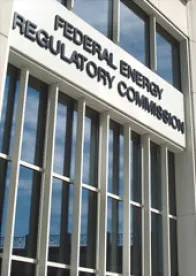On February 15, 2018, the Federal Energy Regulatory Commission (“FERC”) adopted a final rule (“Order No. 841”)[1]that facilitates the direct participation of electric storage resources in centralized markets operated by Regional Transmission Organizations (“RTOs”) and Independent System Operators (“ISOs”). In its order, FERC directs RTOs and ISOs to revise their tariffs to establish a new participation model that recognizes the physical and operational characteristics of electric storage resources to facilitate the participation of these resources in centralized markets. Rather than imposing a specific participation model on the RTOs and ISOs, FERC instead sets forth certain minimum requirements that each RTO and ISO must meet when proposing market rules to establish the participation model for electric storage resources.[2] FERC defines an electric storage resource as one capable of receiving electric energy from the grid and storing it for later injection of electric energy back to the grid, and FERC makes clear that the definition is intended to cover a range of technologies that includes batteries, flywheels and hydro pumped storage.[3] FERC requires that new participation models put forward by RTOs and ISOs must ensure that:
- an electric storage resource is eligible to provide all capacity, energy, and ancillary services that the resource is technically capable of providing in the particular RTO or ISO markets;
- an electric storage resource using the model can be dispatched and can set the wholesale market clearing price as both a wholesale seller and wholesale buyer consistent with the existing market rules;
- the model accounts for the physical and operational characteristics of electric storage resources through bidding parameters or other means;
- the minimum size requirement for participation in the RTO/ISO markets may not exceed 100 kW; and
- the sale of electric energy from the RTO and ISO markets to an electric storage resource that the resource then resells back to those markets is at the wholesale locational marginal price (“LMP”).[4]
Order No. 841 prohibits RTOs and ISOs from establishing a minimum size threshold above 100 kW for electric storage resources to be eligible to buy and sell energy at the wholesale LMP in centralized markets directly.[5] To the extent lower thresholds are established by RTOs and ISOs, the number of resources that qualify to participate directly in RTO and ISO markets may increase. However, depending on the applicable interconnection process discussed below, electric storage resources may also be subject to certain study deposits or other requirements to facilitate interconnection of the resources.
Commenters raised concerns that the participation model may be abused by retail customers seeking to avoid paying the retail rate for energy consumption by falsely claiming such purchases are for wholesale purposes to charge the storage facilities and later sell back to the wholesale market. FERC addresses these concerns by requiring the implementation of certain direct metering and accounting practices that distinguish between wholesale and retail activity.[6] Specifically, Order No. 841 requires each RTO and ISO to meter electric storage resources that will participate in the wholesale markets directly in order to measure all the energy both entering and exiting the resource. FERC also recognizes that other metering requirements for electric storage resources, such as those located on a distribution system or behind a customer meter, could be used in lieu of a direct metering requirement.[7]
Features of Participation in Centralized RTO and ISO Markets
Order No. 841 is intended to incent the development and ISO and RTO market participation of a variety of electric storage resources, including resources located on distribution systems or behind the meter.[8] An electric storage resource that receives, stores and later injects electric energy into the grid as part of its participation in RTO or ISO markets engages in a FERC-jurisdictional sale of electric energy at wholesale, regardless of whether the electric storage resource is located on the transmission system, on a distribution system, or behind the meter.[9] The participation in wholesale markets of such electric storage resources, including those connected at or below distribution-level voltages, means that these electric storage resources will become subject to FERC’s rules and regulations pursuant to the Federal Power Act (“FPA”).[10] Thus, while Order No. 841 eases market access for electric storage resources to participate in centralized power markets, the result of such participation may require compliance by the owners of those resources – including relatively small resources of 100 kW – with a wide range of FERC requirements pursuant to the FPA, potentially including filing rates pursuant to FPA section 205, obtaining market-based rate authority where applicable, submitting FPA section 203 filings related to corporate mergers, FERC accounting obligations and FERC interlocking directorate obligations.[11] Some electric storage resources that choose directly to participate in the RTO and ISO markets may seek relief or exemptions at FERC from certain regulatory requirements of the FPA.[12]
Another feature of Order No. 841’s application to resources located on both the distribution and transmission system may be inconsistent interconnection procedures for connecting electric storage resources. Specifically, interconnection of such resources to transmission facilities covered by a transmission provider’s Open Access Transmission Tariff (“OATT”) will be subject to FERC’s pro forma interconnection procedures, while interconnection to distribution facilities that are not covered by a transmission provider’s OATT will be subject to state interconnection procedures. Additionally, many states do not have uniform or pro forma interconnection procedures and instead, interconnection procedures are handled by the states through individual filings with the state regulatory commissions. As a result, the interconnection process for electric storage resources may vary widely depending on the point of interconnection across the electric system and from state to state.
Energy Storage Resources and Renewables Benefit, but Some Existing Resources are Challenged by Order No. 841
Order No. 841 benefits the energy storage industry by expanding the viability of electric storage resources into larger ancillary services and wholesale energy and capacity markets beyond the current limited applications that generally involve fast-responding frequency regulation markets. Order No. 841’s requirements may result in energy storage providers having an identified revenue source, which can further facilitate financing and deployment of such projects.
Renewable energy resources may also benefit from Order No. 841 by the increasing interest in co-locating or co-developing renewable facilities with electric storage resources to address the operational challenges of some renewable energy production to dispatch quickly and “firm up” portions of the variable production of some renewable resources like wind and solar. To the extent Order No. 841 broadens the deployment of electric storage resources, such increased availability may make renewable development options more attractive to pair with the increased storage availability.
Many anticipate that Order No. 841 could result in challenges for the owners of certain merchant facilities, including marginally economic peaker units. To the extent that traditional peaker units only run during brief periods of high demand for electricity, electric storage resources may be capable of dispatching more economically to address the demand and may displace such peaker units and keep them from clearing the market. In this respect, the rule may make it difficult for certain marginal peaker units to participate economically in RTO and ISO markets if the increased participation of electric storage units encouraged by Order No. 841 takes place as FERC anticipates.
Aggregation of Distributed Storage Resources Separated for Further Consideration
Although FERC’s earlier proposal contained reforms related to the participation of aggregated distributed electric storage resources that may be too small on their own to participate in centralized RTO and ISO markets directly, Order No. 841 does not adopt the earlier proposed reforms for distributed energy resource aggregation.[13] Instead, FERC concludes that additional information related to aggregation of electric storage resources is necessary. Therefore, FERC concurrently issued a Notice of Technical Conference in Docket No. RM18-9-000 to aid FERC’s consideration of possible future reforms for distributed energy resource aggregation. FERC scheduled the technical conference for April 10-11, 2018.[14] As a result, FERC has avoided, for now, the need to address various operational and jurisdictional aspects of wholesale market participation by aggregated distributed energy resources.
Implementation of Order No. 841
RTOs and ISOs must submit compliance filings within 270 days of publication of Order No. 841 in the Federal Register, and the final rule gives each RTO and ISO an additional 365 days following the submission of the compliance filing to implement the tariff revisions.[15]
[1] Electric Storage Participation in Markets Operated by Regional Transmission Organizations and Independent System Operators, Order No. 841, 162 FERC ¶ 61,127 (2018).
[2] Id. P 53.
[3] Id. P 29.
[4] Id. P 4.
[5] Id. PP 266, 271.
[6] Order No. 841 P 317.
[7] Id. P 317.
[8] Id. P 29. FERC notes that behind-the-meter resources that do not inject electric energy onto the grid are considered demand response, and FERC expressly declares that it does not intend the requirements of Order No. 841 to disrupt or conflict with existing demand response rules. Id. P 32.
[9] Id. PP 29-30 (noting that injections of electric energy to the grid for purposes of participating in a state net metering program when the facility consumes more power than it produces over the relevant netting period does not trigger FERC jurisdiction and citing Sun Edison LLC, 129 FERC ¶ 61,146 (2009), reh’g granted on other grounds, 131 FERC ¶ 61,213 (2010)).
[10] See id. PP 30, 35.
[11] See id. P 30.
[12] For example, FERC has granted Exempt Wholesale Generator (“EWG”) status to the owners of battery storage facilities that are determined to be engaged directly and exclusively in selling electric energy at wholesale, which status provides exemptions from certain regulatory requirements at FERC. See AES ES Westover, LLC, 131 FERC ¶ 61,008 (2010). With regard to Qualifying Facility (“QF”) status for electric storage resources pursuant to the Public Utility Regulatory Policies Act of 1978, as amended (“PURPA”), FERC has specifically held that certain storage resources, including battery systems, “are a renewable resource for purposes of QF certification,” subject to meeting PURPA’s fuel use requirements. Specifically, PURPA requires that at least 75 percent of the primary energy source used to charge a small power production QF must be from a renewable resources (hydro, wind or solar), biomass, waste or geothermal resource. See Luz Development and Finance Corp., 51 FERC ¶ 61,078 (1990). Thus, PURPA’s fuel use requirements may limit the ability for certain electric storage resources to obtain QF status if they receive electric energy from the grid to charge the storage facilities.
[13] Order No. 841 at P 5.
[14] Notice of Technical Conference, Docket Nos. RM18-9-000 and AD18-10-000 (2018).
[15] Order No. 841 at PP 343-44.




 />i
/>i

